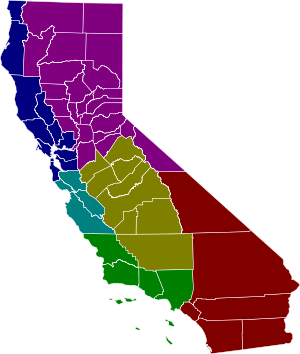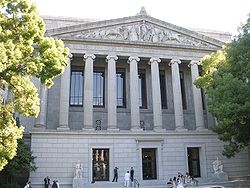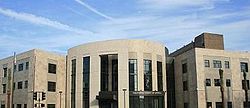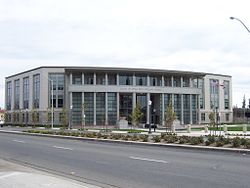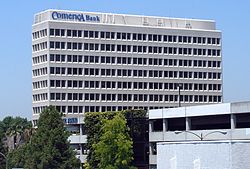- California Courts of Appeal
-
The California Courts of Appeal are the state intermediate appellate courts in the U.S. state of California. The state is geographically divided into six appellate districts.[1] The Courts of Appeal form the largest state-level intermediate appellate court system in the United States, with 105 justices.
Contents
Jurisdiction and responsibility
The decisions of the Courts of Appeal are binding on the Superior Courts of California, and both the Courts of Appeal and the Superior Courts are bound by the decisions of the Supreme Court of California. Notably, all published California appellate decisions are binding on all trial courts,[2] (distinct from the practice in the federal courts and in other state court systems in which trial courts are bound only by the appellate decisions from the particular circuit in which it sits, as well as the Supreme Court of the United States or the state supreme court).[3] Court of Appeal decisions are not binding between divisions or even between panels of the same division.[4]
It is customary in federal courts and other state courts to indicate in case citations the particular circuit or district of an intermediate appellate court that issued the decision cited. But because the decisions of all six California appellate districts are equally binding upon all trial courts, district numbers are traditionally omitted in California citation style unless an actual interdistrict conflict is at issue.
All California appellate courts are required by the California Constitution to decide criminal cases in writing with reasons stated (meaning that even in criminal appeals where the defendant's own lawyer has tacitly conceded that the appeal has no merit,[5] the appellate decision must summarize the facts and law of the case and review possible issues independently before concluding that the appeal is without merit).[6] Such procedure is not mandated for civil cases, but for certain types of civil cases where a liberty interest is implicated, the Courts of Appeal may, but are not required to, follow a similar procedure.[7][8] Most Court of Appeal opinions are not published and have no precedential value;[9] the opinions that are published are included in the California Appellate Reports.
Due to their huge caseloads and volume of output, the Courts of Appeal in turn see the largest number of decisions appealed to the state supreme court and the Supreme Court of the United States. A few famous U.S. Supreme Court cases, such as Burnham v. Superior Court of California, came to the high court on writ of certiorari to one of the Courts of Appeal after the state supreme court had denied review. Many Court of Appeal opinions have become nationally prominent in their own right, such as the 1959 opinion that carved out the first judge-made exception to the at-will employment doctrine, the 1980 opinion that authorized a cause of action for wrongful life, and the 1984 opinion that created the right to Cumis counsel.
History
The California Constitution originally made the Supreme Court the only appellate court for the whole state. As the state's population skyrocketed during the 19th century, the Supreme Court was expanded from three to seven justices, and then the Court began hearing the majority of appeals in three-justice panels. The Court became so overloaded that it frequently issued summary dispositions in minor cases, meaning that it was merely saying "affirmed" or "reversed" without saying why. The state's second Constitution, enacted in 1879, halted that practice by expressly requiring the Court to issue every dispositive decision in writing "with reasons stated." In 1889, the Legislature authorized the Supreme Court to appoint five commissioners to help with its work.
Despite implementing all these measures, the Supreme Court was no longer able to keep up with the state's rapidly growing appellate caseload by the end of the 19th century. Accordingly, in 1903, the Legislature proposed a constitutional amendment to create what were then called the District Courts of Appeal. On November 8, 1904, the electorate adopted the amendment.
The District Courts of Appeal originally consisted of three appellate districts, headquartered in San Francisco, Los Angeles, and Sacramento, with three justices each. These first nine justices were appointed by the Governor. Each district was assigned an ordinal number (i.e., first, second, and third).
In 1966, the word "District" was dropped from the official names of the Courts of Appeal. Since then, each of them has been named officially as "the Court of Appeal of the State of California" for a particular appellate district.
Organization
When there is a vacancy on the Supreme Court of California, or if a Supreme Court justice recuses him or herself from a case, a Court of Appeal justice is temporarily assigned to hear each Supreme Court case requiring such assignment. When there are vacancies on the Court of Appeal, the Chief Justice of the Supreme Court temporarily assigns a judge from the superior court to sit as a Court of Appeal justice.
Some of the appellate districts (First and Second) are divided into divisions that have four appellate justices, who are randomly selected to form three-justice panels for each appellate case, and whose workloads are divided semi-randomly to ensure even division of work. Some of the appellate districts (Third, Fifth, and Sixth) are not divided into divisions; for each appellate case, three-justice panels are semi-randomly drawn, again to ensure even division of work. The Fourth District is unique in that it is divided into three geographically-based divisions that are administratively separate, each of which works much like the Third, Fifth, and Sixth Districts. When the presiding justice of a district or division is part of the three-justice panel, he/she serves as the presiding justice on the case. When the presiding justice is not part of the three-justice panel, the senior justice of the three-justice panel serves as the acting presiding justice on the case.
The First, Second, and Third Districts each have one big courtroom at their main courthouses which they share with the Supreme Court of California. Therefore, on a typical weekday, the courtrooms of those districts will have three Court of Appeal justices seated at an extra-wide bench large enough to accommodate the seven justices of the Supreme Court.
First District
The California Court of Appeal for the First District is one of the first three appellate districts created in 1904 and is located in San Francisco. Its jurisdiction is over the following counties: Alameda, Contra Costa, Del Norte, Humboldt, Lake, Marin, Mendocino, Napa, San Francisco, San Mateo, Solano, and Sonoma. It is divided into five non-geographical divisions with four justices each:
Division One:
- James J. Marchiano, Presiding Justice
- Sandra L. Margulies, Associate Justice
- Robert L. Dondero, Associate Justice
- Kathleen M. Banke, Associate Justice
Division Two:
- J. Anthony Kline, Presiding Justice
- Paul R. Haerle, Associate Justice
- James R. Lambden, Associate Justice
- James A. Richman, Associate Justice
Division Three:
- William R. McGuiness, Presiding Justice
- Stuart R. Pollak, Associate Justice
- Peter J. Siggins, Associate Justice
- Martin J. Jenkins, Associate Justice
Division Four:
- Ignazio J. Ruvolo, Presiding Justice
- Timothy A. Reardon, Associate Justice
- Patricia K. Sepulveda, Associate Justice
- Maria P. Rivera, Associate Justice
Division Five:
- Barbara J. R. Jones, Presiding Justice
- Mark B. Simons, Associate Justice
- Henry E. Needham, Jr., Associate Justice
- Terence L. Bruiniers, Associate Justice
Clerk/Administrator: Diana J. Herbert
Assistant Clerk/Administrator: Susan Graham
Second District
The California Court of Appeal for the Second District is one of the first three appellate districts created in 1904 and has its main courthouse in Los Angeles and the secondary courthouse, hosting Division Six, in Ventura. Division Six handles appeals from San Luis Obispo, Santa Barbara, and Ventura Counties, while Divisions One through Five, Seven, and Eight handle appeals from Los Angeles County. Each division has four justices.
Division One:
- Robert M. Mallano, Presiding Justice
- Frances Rothschild, Associate Justice
- Victoria Gerrard Chaney, Associate Justice
- Jeffrey W. Johnson, Associate Justice
Division Two:
- Roger W. Boren, Presiding Justice
- Kathryn Doi Todd, Associate Justice
- Judith M. Ashmann-Gerst, Associate Justice
- Victoria M. Chavez, Associate Justice
Division Three:
- Joan D. Klein, Presiding Justice
- H. Walter Croskey, Associate Justice
- Patti S. Kitching, Associate Justice
- Richard D. Aldrich, Associate Justice
Division Four:
- Norman L. Epstein, Presiding Justice
- Thomas L. Willhite, Jr., Associate Justice
- Nora Margaret Manella, Associate Justice
- Steven C. Suzukawa, Associate Justice
Division Five:
- Paul Turner, Presiding Justice
- Orville A. Armstrong, Associate Justice
- Richard M. Mosk, Associate Justice
- Sandy R. Kriegler, Associate Justice
Division Six:
- Arthur Gilbert, Presiding Justice
- Kenneth R. Yegan, Associate Justice
- Paul H. Coffee, Associate Justice
- Steven Z. Perren, Associate Justice
Division Seven:
- Dennis M. Perluss, Presiding Justice
- Fred Woods, Associate Justice
- Laurie D. Zelon, Associate Justice
- Frank Y. Jackson, Associate Justice
Division Eight:
- Tricia A. Bigelow, Presiding Justice
- Laurence D. Rubin, Associate Justice
- Madeleine I. Flier, Associate Justice
- Elizabeth A. Grimes, Associate Justice
Clerk/Administrator: Joseph A. Lane
Assistant Clerk/Administrators: Daniel P. Potter and Paul McGill
Third District
The California Court of Appeal for the Third District is one of the first three appellate districts created in 1904 and is located in Sacramento. Its jurisdiction is over the following counties: Alpine, Amador, Butte, Calaveras, Colusa, El Dorado, Glenn, Lassen, Modoc, Mono, Nevada, Placer, Plumas, Sacramento, San Joaquin, Shasta, Sierra, Siskiyou, Sutter, Tehama, Trinity, Yolo, and Yuba. It has 11 justices and is not divided into divisions.
Justices:
- Vance W. Raye, Presiding Justice
- Coleman A. Blease, Associate Justice
- George Nicholson, Associate Justice
- Harry Hull, Associate Justice
- Ronald B. Robie, Associate Justice
- M. Kathleen Butz, Associate Justice
- Louis R. Mauro, Associate Justice
- Elena J. Duarte, Associate Justice
- Andrea L. Hoch, Associate Justice
- William J. Murray, Jr., Associate Justice
- Vacant
Clerk/Administrator: Deena C. Fawcett
Assistant Clerk/Administrator: Colete Bruggman
Fourth District
The California Court of Appeal for the Fourth District is unique in that it is divided into three geographical divisions that are administratively separate, which even have different case number systems, and yet remain referred to as a single district.
Division One
 Fourth District, Division One's courthouse at Symphony Towers in San Diego
Fourth District, Division One's courthouse at Symphony Towers in San Diego
The Division One courthouse is located in San Diego. It handles appeals from Imperial and San Diego Counties. It has 10 justices.
Justices:
- Judith McConnell, Presiding Justice
- Patricia D. Benke, Associate Justice
- Richard D. Huffman, Associate Justice
- Gilbert Nares, Associate Justice
- Judith L. Haller, Associate Justice
- Alex C. McDonald, Associate Justice
- James A. McIntyre, Associate Justice
- Terry B. O'Rourke, Associate Justice
- Cynthia Aaron, Associate Justice
- Joan Irion, Associate Justice
Clerk/Administrator: Stephen M. Kelly
Assistant Clerk/Administrator: Kevin J. Lane
Division Two
The Division Two courthouse is located in Riverside. It handles appeals from Inyo, Riverside, and San Bernardino Counties. It has seven justices.
Justices:
- Manuel A. Ramirez, Presiding Justice
- Thomas E. Hollenhorst, Associate Justice
- Art W. McKinster, Associate Justice
- Betty Ann Richli, Associate Justice
- Jeffrey King, Associate Justice
- Douglas P. Miller, Associate Justice
- Carol D. Codrington, Associate Justice
Division Three
The Division Three courthouse is located in Santa Ana. It handles appeals from Orange County. It has eight justices.
Justices:
- (Vacant), Presiding Justice
- William F. Rylaarsdam, Acting Presiding Justice
- William W. Bedsworth, Associate Justice
- Kathleen E. O'Leary, Associate Justice
- Eileen C. Moore, Associate Justice
- Richard M. Aronson, Associate Justice
- Richard F. Fybel, Associate Justice
- Raymond J. Ikola, Associate Justice
History
The Fourth District was formed by a division of the Second District pursuant to legislation enacted sometime before October 16, 1929. The first decision made by the Fourth District was on October 16, 1929, in the case of Mills v. Mills, (1929) 101 Cal.App. 248, [281 P. 707.]
Fifth District
The California Court of Appeal for the Fifth District is located in Fresno. Its jurisdiction covers the following counties: Fresno, Kern, Kings, Madera, Mariposa, Merced, Stanislaus, Tulare, and Tuolumne. It has 10 justices.
Justices:
- Brad R. Hill, Presiding Justice
- Rebecca A. Wiseman, Associate Justice
- Bert Levy, Associate Justice
- Dennis A. Cornell, Associate Justice
- Gene M. Gomes, Associate Justice
- Betty L. Dawson, Associate Justice
- Stephen J. Kane, Associate Justice
- Charles S. Poochigian, Associate Justice
- Jennifer R.S. Detjen, Associate Justice
- Donald R. Franson, Jr., Associate Justice
History
The Fifth District was formed by a division of the Third District pursuant to legislation enacted in 1961 (Stats.1961, c. 845, p. 2128, § 7). The first decision made by the Fifth District was on November 21, 1961, in the case of Wheat v. Morse, (1961) 17 Cal.Rptr. 226, [197 Cal.App.2d 203.]
Sixth District
The California Court of Appeal for the Sixth District is located in the Comerica Bank building in San José. Its jurisdiction covers Monterey, San Benito, Santa Clara, and Santa Cruz Counties. It has seven justices.
Justices:
- Conrad L. Rushing, Presiding Justice
- Eugene M. Premo, Associate Justice
- Franklin D. Elia, Associate Justice
- Patricia Bamattre-Manoukian, Associate Justice
- Nathan D. Mihara, Associate Justice
- Wendy Clark Duffy, Associate Justice
- Vacant
Clerk/Administrator: Michael J Yerly
Assistant Clerk/Administrator: Corrine Pochop
History
The Sixth District was formed by a division of the First District pursuant to legislation enacted in 1981 (Stats.1981, c. 959, p. 3645, § 5). The first decision made by the Sixth District was on December 13, 1984, in the case of People v. Dickens, (1984) 163 Cal.App.3d 377, [208 Cal.Rptr. 751.]
See also
- Supreme Court of California
- Court of Appeals
- Districts in California
Notes
- ^ See California Government Code Section 69100.
- ^ Auto Equity Sales, Inc. v. Superior Court,, 57 Cal. 2d 450, 369 P.2d 937, 20 Cal. Rptr. 321 (1962).
- ^ See, e.g., Reiser v. Residential Funding Corp., 380 F.3d 1027 (7th Cir. 2004).
- ^ McCallum v. McCallum, 190 Cal. App. 3d 308, 315 n.4 (1987).
- ^ The so-called Wende appellate procedure was upheld as compatible with the Fourteenth Amendment in Smith v. Robbins, 528 U.S. 259 (2000).
- ^ People v. Kelly, 40 Cal. 4th 106 (2006).
- ^ Conservatorship of Ben C., 40 Cal. 4th 529, 150 P.3d 738, 53 Cal. Rptr. 3d 856 (2007).
- ^ In re Sade C., 13 Cal. 4th 952, 920 P.2d 716, 55 Cal. Rptr. 2d 771 (1996).
- ^ Schmier v. Supreme Court, 78 Cal. App. 4th 703 (2000). The plaintiff in this case unsuccessfully challenged the selective publication policy as unconstitutional. The court retorted: "Appellant either misunderstands or ignores the realities of the intermediate appellate process." The court went on to describe the variety of frivolous appeals regularly encountered by the Courts of Appeal, and concluded: "Our typical opinions in such cases add nothing to the body of stare decisis, and if published would merely clutter overcrowded library shelves and databases with information utterly useless to anyone other than the actual litigants therein and complicate the search for meaningful precedent."
See also
External links
State Intermediate Appellate Courts Alabama: Civil / Criminal • Alaska • Arizona • Arkansas • California • Colorado • Connecticut • Florida • Georgia • Hawaii • Idaho • Illinois • Indiana • Iowa • Kansas • Kentucky • Louisiana • Maryland • Massachusetts • Michigan • Minnesota • Mississippi • Missouri • Nebraska • New Jersey • New Mexico • New York • North Carolina • North Dakota • Ohio • Oklahoma • Oregon • Pennsylvania: Superior Court / Commonwealth Court • South Carolina • Tennessee: Civil / Criminal • Texas • Utah • Virginia • Washington • WisconsinDelaware, District of Columbia, Maine, Montana, Nevada, New Hampshire, Rhode Island, South Dakota, Vermont, West Virginia, and Wyoming do not have intermediate appellate courts.Categories:- California state courts
- State appellate courts
Wikimedia Foundation. 2010.

